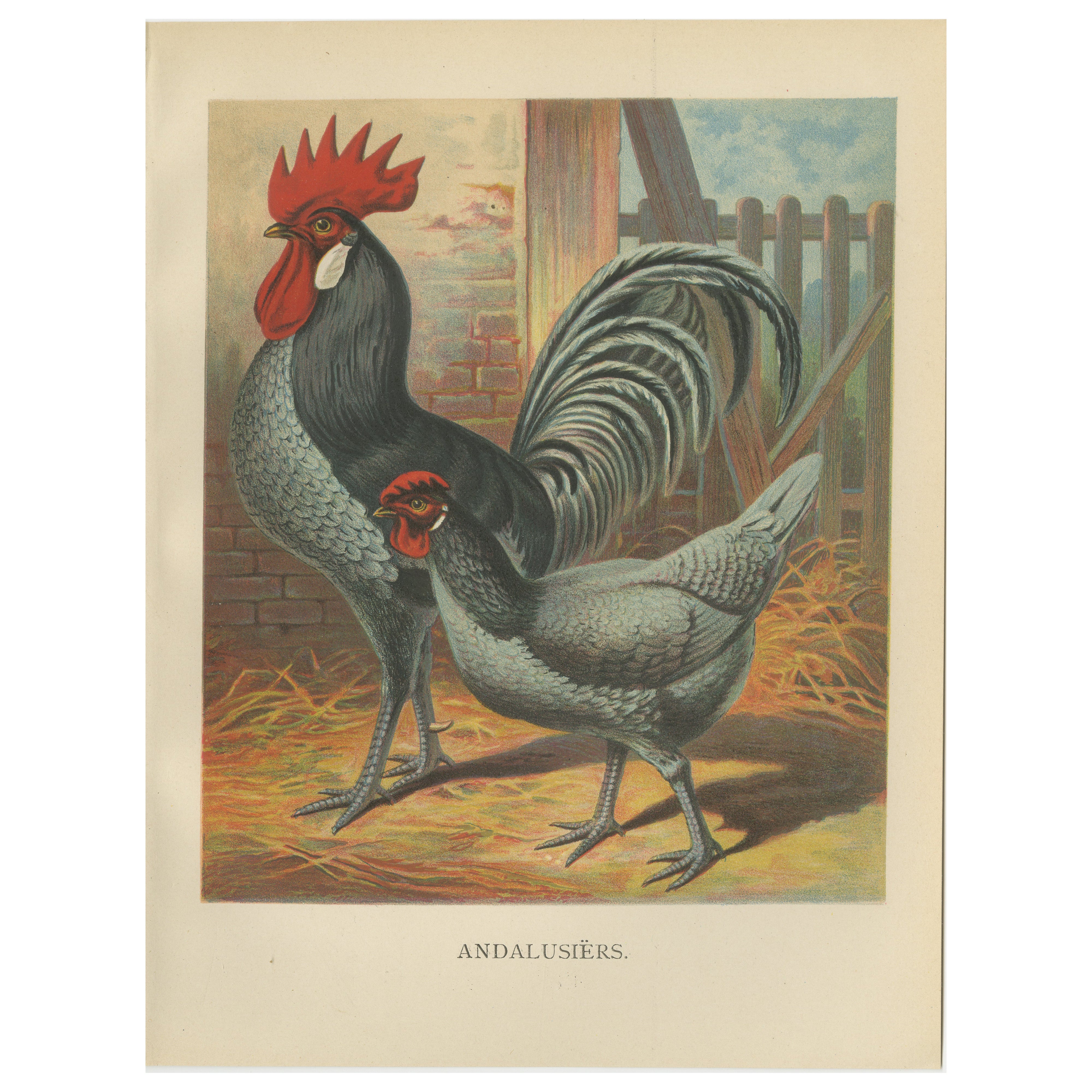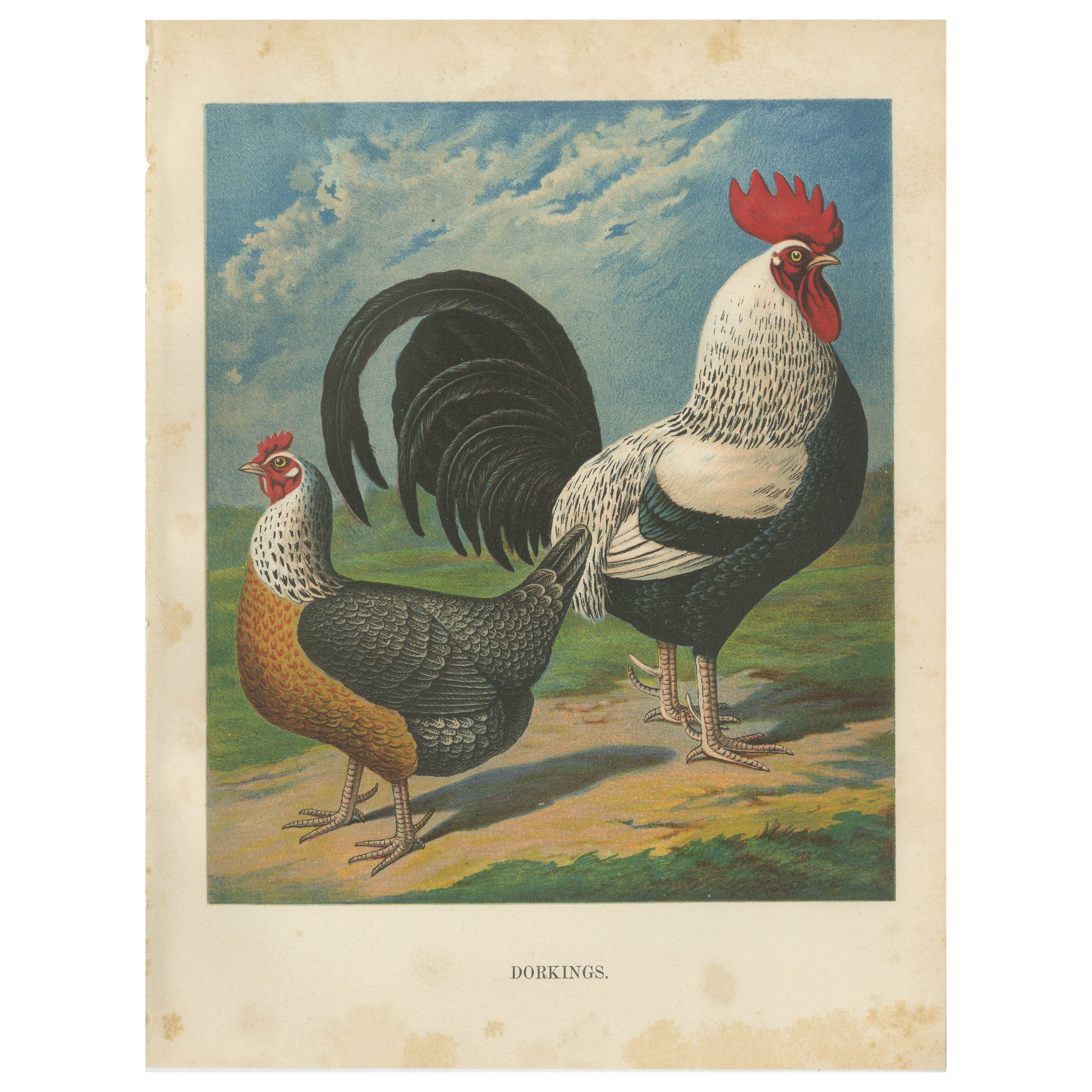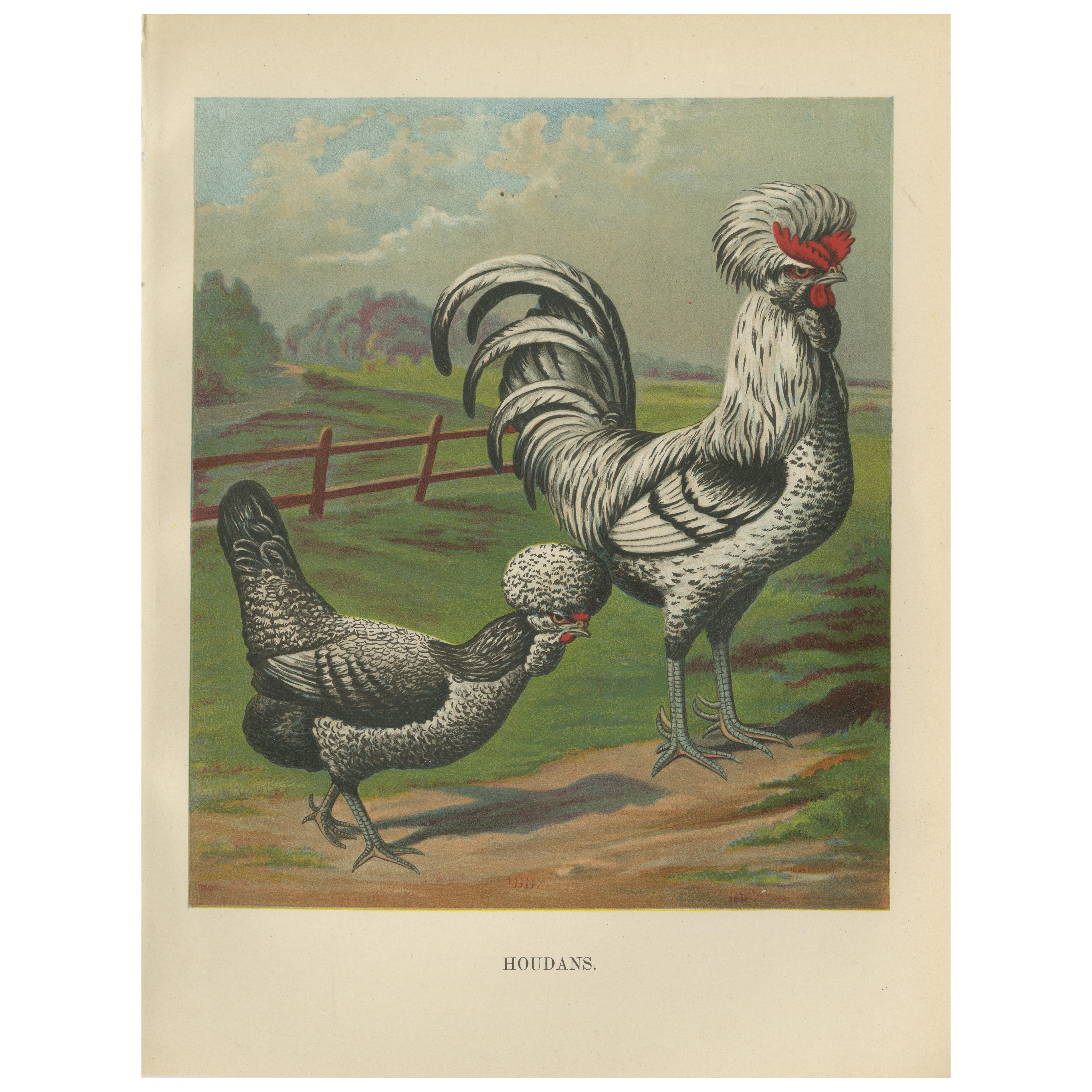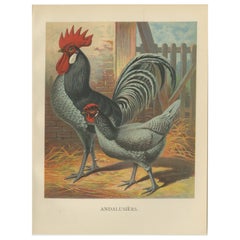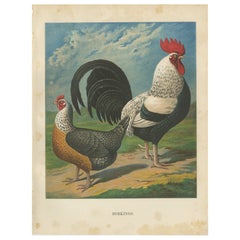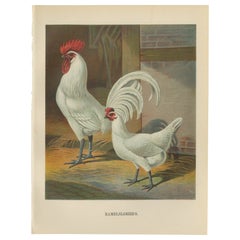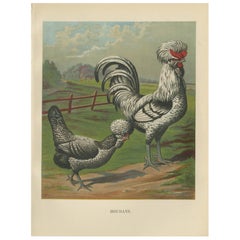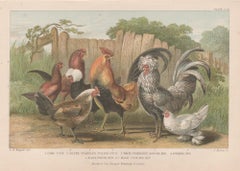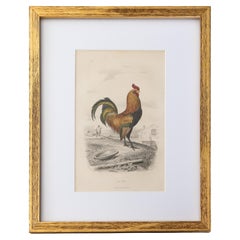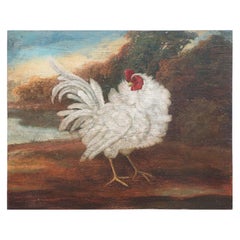Items Similar to The Distinguished Spanish Chicken - A Rare 19th Century Poultry Lithograph
Want more images or videos?
Request additional images or videos from the seller
1 of 10
The Distinguished Spanish Chicken - A Rare 19th Century Poultry Lithograph
$287.46
£213.02
€240
CA$392.43
A$436.57
CHF 228.85
MX$5,334.74
NOK 2,914.17
SEK 2,743.29
DKK 1,827.34
Shipping
Retrieving quote...The 1stDibs Promise:
Authenticity Guarantee,
Money-Back Guarantee,
24-Hour Cancellation
About the Item
The Distinguished Spanish Chicken A Rare 19th Century Poultry Lithograph
This striking 19th century chromolithograph features a pair of Spanish chickens, a distinguished breed known for its sleek black plumage, prominent white facial patches, and regal bearing. The print, titled Spanjaarden, originates from Geïllustreerd Hoenderboek, an Illustrated Poultry Book published in 1888 by Elsevier. Compiled by Julius Volschau and adapted for Dutch readers by Dr. A. C. Oudemans Jzn., this book provided detailed insights into poultry breeding, selection, and care, reflecting the great interest in specialized breeds during the 19th century.
The Spanish chicken, often referred to as the White Faced Black Spanish, is one of the oldest Mediterranean poultry breeds. It is believed to have been developed in Spain before being refined in England during the 18th and 19th centuries. This breed is best recognized for its glossy black feathers, bright red comb, and large white earlobes and facial skin, giving it a striking contrast that made it highly desirable for exhibition purposes. Spanish chickens were prized for their strong egg laying abilities, producing large white eggs consistently, though they were less commonly used as meat birds due to their slender build.
This lithograph was created using chromolithography, a sophisticated 19th century printing technique that allowed for richly detailed and vibrant illustrations. The original artwork was drawn by Christian Förster, a renowned animal illustrator of the period. Chromolithographs were made by layering multiple colors, each applied with a separate stone plate, allowing for depth and realism in the final image. The smooth sheen of the feathers and the delicate shading on the white facial skin in this print showcase the precision and craftsmanship of the technique.
### Condition Summary
The print remains in very good condition, with strong contrast and fine details well preserved. Some minor age related toning and slight foxing spots are present along the edges, which is typical for lithographs of this period. The paper remains stable, with minimal signs of wear, making this a highly collectible piece for enthusiasts of antique poultry illustrations and historical agricultural prints.
### Framing Tips
To best protect and display this lithograph, consider the following framing techniques
- Use acid free matting to prevent long term deterioration. A soft cream or light gray mat can provide a subtle contrast to the dark plumage
- Opt for UV protective glass to shield the colors from light exposure and fading
- A wooden frame in deep walnut, black lacquer, or dark mahogany will complement the striking contrast between the Spanish chicken’s black feathers and white facial markings
- Float mounting can highlight the original paper edges, adding a historical and museum quality presentation
This lithograph is an exceptional example of 19th century poultry illustration, capturing the elegance and rarity of the Spanish chicken breed. Whether displayed in a study, farmhouse, or antique print collection, it serves as a beautiful and historically significant piece of agricultural art.
- Dimensions:Height: 10.63 in (27 cm)Width: 7.88 in (20 cm)Depth: 0.01 in (0.2 mm)
- Materials and Techniques:
- Period:
- Date of Manufacture:1888
- Condition:The print remains in very good condition, with strong contrast and fine details well preserved. Some minor age related toning and slight foxing spots are present along the edges, which is typical for lithographs of this period.
- Seller Location:Langweer, NL
- Reference Number:Seller: BG-14012-101stDibs: LU3054344034182
About the Seller
5.0
Recognized Seller
These prestigious sellers are industry leaders and represent the highest echelon for item quality and design.
Platinum Seller
Premium sellers with a 4.7+ rating and 24-hour response times
Established in 2009
1stDibs seller since 2017
2,502 sales on 1stDibs
Typical response time: <1 hour
- ShippingRetrieving quote...Shipping from: Langweer, Netherlands
- Return Policy
Authenticity Guarantee
In the unlikely event there’s an issue with an item’s authenticity, contact us within 1 year for a full refund. DetailsMoney-Back Guarantee
If your item is not as described, is damaged in transit, or does not arrive, contact us within 7 days for a full refund. Details24-Hour Cancellation
You have a 24-hour grace period in which to reconsider your purchase, with no questions asked.Vetted Professional Sellers
Our world-class sellers must adhere to strict standards for service and quality, maintaining the integrity of our listings.Price-Match Guarantee
If you find that a seller listed the same item for a lower price elsewhere, we’ll match it.Trusted Global Delivery
Our best-in-class carrier network provides specialized shipping options worldwide, including custom delivery.More From This Seller
View AllThe Elegant Andalusian Chicken - A Rare 19th Century Poultry Lithograph
Located in Langweer, NL
The Elegant Andalusian Chicken - A Rare 19th Century Poultry Lithograph
This stunning 19th century chromolithograph features a pair of Andalusian chickens, a striking Mediterranea...
Category
Antique 1880s Prints
Materials
Paper
The Noble Dorking Chicken - A Rare 19th Century Poultry Lithograph
Located in Langweer, NL
The Noble Dorking Chicken A Rare 19th Century Poultry Lithograph
This magnificent 19th century chromolithograph features a pair of Dorking chickens, one of the oldest and most dis...
Category
Antique 1880s Prints
Materials
Paper
The Distinguished Ramelsloher Chicken - A Rare 19th Century Poultry Lithograph
Located in Langweer, NL
The Distinguished Ramelsloher Chicken A Rare 19th Century Poultry Lithograph
This striking 19th-century chromolithograph features a pair of Ramelsloher chickens, a breed known for...
Category
Antique 1880s Prints
Materials
Paper
The Distinguished Houdan Chicken - A Rare 19th Century Poultry Lithograph
Located in Langweer, NL
The Distinguished Houdan Chicken A Rare 19th Century Poultry Lithograph
This stunning 19th century chromolithograph showcases a pair of Houdan chickens, an elegant French breed kn...
Category
Antique 1880s Prints
Materials
Paper
The Elegant Minorca - A Rare 19th Century Poultry Lithograph
Located in Langweer, NL
The Elegant Minorca A Rare 19th Century Poultry Lithograph
This exquisite 19th century chromolithograph showcases a pair of Minorca chickens, a Mediterranean breed known for its striking black plumage, large comb, and excellent egg laying capabilities. The print, titled Minorka’s, originates from Geïllustreerd Hoenderboek, an Illustrated Poultry Book published in 1888 by Elsevier. Compiled by Julius Volschau and adapted for Dutch readers by Dr. A. C. Oudemans Jzn., this book provided a detailed account of poultry breeding and care, reflecting the growing interest in high quality egg producing breeds during the 19th century.
Minorcas, named after the Spanish island of Menorca, are among the most productive of the Mediterranean breeds, known for their ability to lay large white eggs. They were introduced to England in the late 18th century and became highly popular across Europe due to their hardiness and prolific egg production. The breed is characterized by its sleek black feathers, bright red comb and wattles, and distinctive white earlobes, which contrast beautifully against its dark plumage. The Minorca rooster stands tall with an upright posture, while the hen maintains a graceful and refined stance.
This lithograph was created using chromolithography, a 19th century printing process that allowed for vibrant and detailed color reproduction. The illustration is based on an original drawing by Christian Förster, a well known animal illustrator of the time. Chromolithographs were produced by layering multiple colors, each applied with a separate stone plate, ensuring depth and realism in the final image. The lustrous sheen of the Minorca’s feathers and the intricate shading on the comb and wattles highlight the meticulous craftsmanship involved in this artistic technique.
Condition Summary
The print remains in very good condition, with well preserved colors and sharp details. Some minor age related toning and slight foxing spots can be seen along the edges, which is common in lithographs of this period. The paper is stable with only minimal signs of wear, making this an excellent collectible piece for antique poultry print...
Category
Antique 1880s Prints
Materials
Paper
The Regal Partridge Italian Chicken - A Rare 19th Century Poultry Lithograph
Located in Langweer, NL
The Regal Partridge Italian Chicken A Rare 19th Century Poultry Lithograph
This remarkable 19th century chromolithograph features a pair of Partridge Italian chickens, a breed admired for its striking plumage, graceful build, and lively temperament. The print, titled Patrijsveer-Italianen, originates from Geïllustreerd Hoenderboek, an Illustrated Poultry Book published in 1888 by Elsevier. Compiled by Julius Volschau and adapted for Dutch readers by Dr. A. C. Oudemans Jzn., this book provided an extensive guide to poultry breeding, detailing both functional and ornamental breeds highly regarded in the 19th century.
Partridge Italian chickens are a visually striking variety, displaying a rich combination of deep golden-brown, black, and chestnut hues. The rooster in this lithograph stands with an imposing posture, exhibiting its glossy black tail feathers and vibrant golden saddle feathers. The hens are equally beautiful, featuring finely patterned feathering on their backs and wings, transitioning into a warm golden-brown on their chests. This variety is not only known for its beauty but also for its excellent egg-laying abilities and hardy nature, making it a favorite among poultry breeders.
This lithograph was created using chromolithography, a highly skilled 19th-century printing process that allowed for vibrant, multi-colored illustrations. The artwork is based on an original drawing by Christian Förster, a well-known animal illustrator of the time. Chromolithography involved layering multiple colors, each applied with a separate stone plate, to achieve depth, shading, and fine detail. The precision in rendering the intricate feather textures and the interplay of light and shadow in this lithograph highlights the mastery of this technique.
Condition Summary
The print remains in very good condition, with its colors still rich and vibrant. Some minor age-related toning and light foxing are visible along the edges, a common characteristic of lithographs from this period. The paper is stable with minimal signs of wear, making it a valuable collectible for antique poultry print...
Category
Antique 1880s Prints
Materials
Paper
You May Also Like
Chicken and Hens - Original Lithograph - Late 19th Century
Located in Roma, IT
Image dimensions: 18 x 24,3 cm.
Chicken and Hens is a color lithograph contained in the Meyers Konversations-Lexikon (or Meyers Lexikon).
The print is from the encyclopedia Meyers ...
Category
Late 19th Century Animal Prints
Materials
Lithograph
Poultry, English antique bird engraving print, 1879
Located in Melbourne, Victoria
Poultry
Wood-engraving with original colouring. 1879.
160mm by 245mm (sheet).
Key below the image. From Oliver Goldsmith's 'A History of the Earth and Animated Nature'.
Category
Late 19th Century Victorian Animal Prints
Materials
Engraving
Custom Framed Antique Rooster Engraving
By Georges-Louis Leclerc, Comte de Buffon
Located in Pearland, TX
Georges-Louis Leclerc, Count of Buffon (1707-1788) was a French naturalist, mathematician, and cosmologist. Buffon published thirty-six quarto volumes of his most well-known work, Hi...
Category
Antique 1850s French Decorative Art
Materials
Other
Rooster in Nature Print on Wood
Located in Queens, NY
English Victorian style (20th Century) print of a rooster standing on red clay and looking to the side, in front of a blue pond and autumnal trees, on...
Category
20th Century American Mid-Century Modern Paintings
Materials
Wood
Chicken Family - Lithograph by W. French - Late 19th Century
Located in Roma, IT
A Chicken Family is an original print realized by William French (1815 ca.-1898) in the late 19th century.
Black and white lithograph. Original Title: ...
Category
Late 19th Century Animal Prints
Materials
Lithograph
Rooster Original Oil Painting by E. Tapia
Located in Coeur d'Alene, ID
Original oil painting by E. Tapia. Piece portrays a colorful rooster against gold background on grass. Rooster features colors of blue, gold, red, cream, and green. A well done paint...
Category
2010s American Paintings
Materials
Canvas, Paint
More Ways To Browse
1790 English Porcelain
17th Century French Commodes
19th Century Chest Of Drawers With Key Hole
1960s Pool Table
19th Century Pennsylvania Chest
2 Tier Tray
4 M Long Dining Tables
6 Foot Mirror
8 Panel Asian Screens
African Fertility Sculpture
African Head Rest
African Spears
Airplane Wing
Antique African Pottery
Antique Bar Cart With Wheels
Antique Blanket Box Coffee Table
Antique Brass And Cast Iron Beds
Antique Brass Charger
